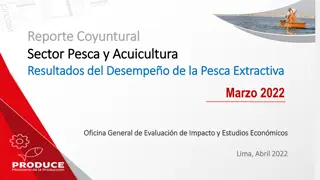
Historical Insights on Native American Tribes and Foodways
Explore the rich history of Native American tribes, dating back to 50,000 years ago. Discover their diverse cultural traditions, food practices, and the challenges they have faced through centuries of conquest and resistance. Learn about the unique characteristics of different tribal groups, their traditional foods, and the importance of harmony and balance in their societies.
Download Presentation

Please find below an Image/Link to download the presentation.
The content on the website is provided AS IS for your information and personal use only. It may not be sold, licensed, or shared on other websites without obtaining consent from the author. If you encounter any issues during the download, it is possible that the publisher has removed the file from their server.
You are allowed to download the files provided on this website for personal or commercial use, subject to the condition that they are used lawfully. All files are the property of their respective owners.
The content on the website is provided AS IS for your information and personal use only. It may not be sold, licensed, or shared on other websites without obtaining consent from the author.
E N D
Presentation Transcript
First natives may have come as long ago as 50,000 years. Theory was that they crossed the Bering straits from Asia when ocean levels were lower Tribes represent greatest number of ethnic subgroups than in any other minority culture (over 400 tribes/nations)
Over several millennia the foodways of Native Americans were well established and included both wild and domesticated foods, traditions that have continued to evolve through the centuries of conquest, assimilation, and resistance that began with European contact in the fifteenth century.
Contrary to popular stereotypes, not all Native Americans were horse-riding bison hunters who lived in tepees. Although these elements fit some historical contexts, they ignore actual regional and cultural differences.
Alaska- Eskimo, Indian, Aleut Northwest- Yakima, Spokan, Klamath California- Shasta, Maidu, Miwok Southwest- Apache, Hopi, Navajo Plains- Cheyenne, Sioux, Shoshone Southeast- 5 Civilized Tribes Cherokees, Chickasaws, Choctaws, Creeks and Seminoles Northeast- Iroquois, Mohawk
Many Native Americans were located to reservations away from their native territories and foods Food and other subsidies were often poor excuses for nutrition Others have been able to stay on near their tribal grounds, mainly in NE and SW, AK, CA and OK Health care is marginal
Harmony Balance between spiritual, social and physical needs Generosity Competitiveness was/is discouraged Individual rights regarded highly, matrilineal societies Present oriented
Indigenous foods: Fruits from North: berries, cherries, grapes, to more tropical guava, papaya, pineapple Vegetables mainly pumpkins, beans, squash, tomatoes, peppers, avocados Beans were planted around corn stalks for support; then squash planted around the beans to help keep soil cool and moist Grains mainly corn and wild rice
Tubers and roots, e,g, cassava, potatoes, sweet potatoes, Jerusalem artichokes Nuts/seeds from tree nuts, peanuts, pumpkin and sunflower Meats were mainly turkey and small game, unless lived near coast (lots of shellfish) or near buffalo/ antelope areas Later introduction of pigs and sheep by Europeans had a big impact on protein status
Northeast Abundance of fish and produce (fruits and vegetables) Many New England foods today influence Clambakes, lobster Baked beans and corn meal breads Succotash stew of corn, beans and fish Corn pudding, pumpkin pie, cranberries Many different shellfish and small game Northeast
Southeast Warmer climate oysters, shrimp and crabs Abundant small game and produce (Brunswick squirrel stew) Hominy and grits (ground corn) Corn, bean squash trio Nuts, berries, fruits and honey Southeast
Northern Plains Bison was staple meat for the Cheyenne, Crow, Arapaho, Dakota and Pawnee tribes; every part of it was used Corn, beans, squash grown in river valleys Small game also hunted and cooked with wild rice, berries, nuts fruits Bison dried into jerky or mixed with berries and fat for travel- called pemmican and stored in parfleches (leather pouches) Northern Plains
Southwest Oldest communities date back to the steep river canyons in the dry deserts Traditional corn, beans, squash trio raised with chilies for flavor; pinto beans from Mexico Originally lived on small game, but now raise sheep Pulp of cactus, yucca and mescal used Southwest
Northwest and Alaska Coastal areas of NW and S Alaska have abundance of seafood and produce The Northern realms are often permafrost and inhabited mainly by Eskimos (Inuits) in the north, and Aleuts along the 1,000 mile long chain of islands called the Aleutians Fish, sea mammals, bear, elk are mainstays of diet with some foraged fruits and vegetables Muktuk: blubber a favorite tundra tea from bog shrub Northwest and Alaska
California Miwok and Pomo tribes lived mainly on ground acorns from which the bitter tannins had been leached Many small California tribes were just marginal hunter-gatherers and ate whatever they could find California
Corn was perhaps the greatest gift that the Native Americans bestowed upon the white settlers. The early Pilgrims of Plymouth and the colonists at Jamestown settlements were saved from starvation by harvests of corn. It is believed that the settlement of America by white colonists would have been delayed 100 years if it hadn't been for the availability of corn for food.
Native Americans had 50 different recipes for serving corn which included corn on the cob, roasted ears, hominy, mush, popcorn, corn bread, johnnycake, puddings, succotash, and varieties of corn soup. Parched or dried corn was stored in bark barrels or hung up in bunches in the longhouse
Native American legend states that corn, bean and squash plants were three loving sisters that must always be planted together. The Iroquois learned to make maple syrup from the maple tree. Early French visitors to Indian villages were served popcorn mixed with maple syrup. The French called it "snow food". Today, we call it crackerjacks.
Green (unripened) corn is the central element in: "Green Corn" ceremonies, The Busk ceremony of the southeastern cultures, which signals the beginning of a new year, Annual Schemitzun (Green Corn Festival) of the Mashantucket Pequot held near Ledyard, Connecticut, gathers nations from across the country for a huge powow. Green corn is now a major item of American foodways when consumed as sweet corn, a mutated variety of maize that concentrates a sugar rather than a starch component.
Native American made beverages from different plants. One was a type of coffee made from roasted corn. Another brew was made from sunflower seeds. Tea was made from most berries. A popular summer beverage much like lemonade was concocted by using the berries from the stag horn sumac.
Many stereotype Native American Foods with Fry bread Fry bread was born out of the imprisonment of Navajos and Apaches by the U.S. government in 1863. Their rations consisted of wheat flour and lard, and they made the best of their rations
Northeast: one large hearty meal consumed before noon. Soups and snacks for the rest of the day. Roasted game usually served during the meal. Coastal: consumed salmon at least twice a day with edible greens and roots
Southwest and Northwest: 2 meals per day common. Breakfast at sunrise and dinner before sunset Native American meals were monotonous Common foods included cornmeal gruel or bread, boiled dehydrated vegetables Game, fresh veg and fruits when available Southwest: baked cornmeal in adobo ovens
The cooking traditions of Native Americans included everything from stone-boiling in leather bags to roasting and baking in earth ovens. Cooking methods simple Roasted over fire or ashes, foods cooked in forms of soups and stews Preservation by sun drying or smoking Fermentation in pits with berries, greens and fruits Men ate first followed by women and children in silence
The daily diet of most Native Americans does not contain traditional foods. Diet reflects that of low-to middle-income families who often buy food for its bulk, not its nutritional value Unfortunately, for many tribes the traditional food habits continue to fade
The combination of commoditieshighly refined white flour, sugar, and lard are the basis of a common Indian food, fry bread. Go to any powwow and fry bread will be available. A variant that includes toppings like spicy ground beef and/or beans is called an "Indian taco."
Alarming rate of adult-onset (Type 2) diabetes is over three times that of the rest of the U.S. population as a whole. Explanations for this phenomenon have included the thrifty genotype" model, which explains that such a genotype would have given a genetic advantage to populations who experienced periods of feast and famine.
The epidemic rise in diet-related health problems like diabetes, CAD, HTN and obesity has been most pronounced in the decades following World War II. The promotion of an American diet and lifestyle to assimilate into the U.S. mainstream





















